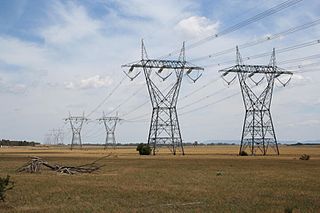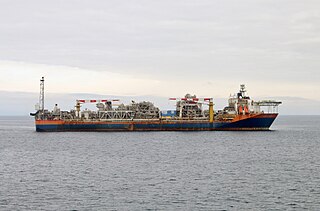Related Research Articles

Pumped-storage hydroelectricity (PSH), or pumped hydroelectric energy storage (PHES), is a type of hydroelectric energy storage used by electric power systems for load balancing. The method stores energy in the form of gravitational potential energy of water, pumped from a lower elevation reservoir to a higher elevation. Low-cost surplus off-peak electric power is typically used to run the pumps. During periods of high electrical demand, the stored water is released through turbines to produce electric power. Although the losses of the pumping process make the plant a net consumer of energy overall, the system increases revenue by selling more electricity during periods of peak demand, when electricity prices are highest. If the upper lake collects significant rainfall or is fed by a river then the plant may be a net energy producer in the manner of a traditional hydroelectric plant.
EnergyAustralia is an electricity generation, electricity and gas retailing private company in Australia, a wholly owned subsidiary of the Hong Kong-based and listed China Light and Power. EnergyAustralia also had a portfolio of generating sites using thermal coal, natural gas, hydro-electric, solar energy, and wind power.
Canada's natural gas liquids industry dates back to the discovery of wet natural gas at Turner Valley, Alberta in 1914. The gas was less important than the natural gasoline - "skunk gas" it was called, because of its distinctive odour - that early producers extracted from it. That natural gas liquid (NGL) could be poured directly into an automobile's fuel tank.
Rough is a natural gas storage facility under the North Sea off the east coast of England. It is capable of storing 100 billion cubic feet of gas, nearly double the storage capacities in operation in Great Britain in 2021.

The SEA Gas pipeline(South East Australia Gas pipeline) is a 687 km natural gas pipeline from the Iona Gas Plant near Port Campbell in Victoria to the Pelican Point Power Station at Port Adelaide. It connects Adelaide's gas supply to sources from Victoria's Otway Basin, thus increasing the security of natural gas supply to Adelaide. The pipeline is owned and operated by South East Australia Gas Pty Ltd who are owned in a 50-50 partnership by APA Group (Australia) and the Retail Employees Superannuation Trust.
Natural gas is a commodity that can be stored for an indefinite period of time in natural gas storage facilities for later consumption.

Energy in Victoria, Australia is generated using a number of fuels or technologies, including coal, natural gas and renewable energy sources. Brown coal, historically, was the main primary energy source for the generation of electricity in the state, accounting for about 85% of electricity generation in 2008. The amount of coal-fired power has decreased significantly with the closure in 2017 of the Hazelwood power station which supplied around 20% of Victoria's electricity, and to a lesser extent with the exit of Anglesea power station in 2015. Brown coal is one of the largest contributors to Australia's total domestic greenhouse gas emissions and a source of controversy for the country. Australia is one of the highest polluters of greenhouse gas per capita in the world.

Norne is an oil field located around 80 kilometres (50 mi) north of the Heidrun oil field in the Norwegian Sea. The sea depth in the area is 380 metres (1,250 ft). Norne lies in a licence which was awarded in 1986, and embraces blocks 6608/10 and 6608/11. The Alve field nearby started to produce in March 2009 and is commingling into Norne. The Urd field is also comingling with the Norne. 6507/3-1 Alve will be tied to Norne for processing and transport. Natural gas has also been exported from Norne since 2001. It travels through the Norne Gas Export Pipeline and the Åsgard Transport trunkline via Kårstø north of Stavanger to continental Europe.
Carbon capture and storage (CCS) is a technology that can capture carbon dioxide CO2 emissions produced from fossil fuels in electricity, industrial processes which prevents CO2 from entering the atmosphere. Carbon capture and storage is also used to sequester CO2 filtered out of natural gas from certain natural gas fields. While typically the CO2 has no value after being stored, Enhanced Oil Recovery uses CO2 to increase yield from declining oil fields.

The Easington Gas Terminal is one of six main gas terminals in the UK, and is situated on the North Sea coast at Easington, East Riding of Yorkshire and Dimlington. The other main gas terminals are at St Fergus, Aberdeenshire; Bacton, Norfolk; Teesside; Theddlethorpe, Lincolnshire and Rampside gas terminal, Barrow, Cumbria. The whole site consists of four plants: two run by Perenco, one by Centrica and one by Gassco. The Easington Gas Terminals are protected by Ministry of Defence Police officers and are provided with resources by the Centre for the Protection of National Infrastructure.

National Fuel Gas Company is a diversified energy company with $6.2 billion in assets distributed among the following five operating segments: Exploration and Production, Pipeline and Storage, Gathering, Utility, and Energy Marketing. National Fuel Gas was incorporated in 1902 and is based in Williamsville, New York.

The Bacton Gas Terminal is a complex of six gas terminals within four sites located on the North Sea coast of North Norfolk in the United Kingdom. The sites are near Paston and between Bacton and Mundesley; the nearest town is North Walsham.

Haidach gas storage is an underground natural gas storage in the town of Haidach near Salzburg, Austria. As of the end of 2018 with a capacity of ~2.9 billion cubic meters (bcm) it is the third largest gas storage facility in Central Europe.

The oil and gas industry in New Zealand explores and develops oil and gas fields, and produces and distributes petroleum products and natural gas.
Ladbroke Grove Power Station is a gas-fired power station in the locality of Monbulla near Penola in the Limestone Coast region of South Australia. It was built by Boral Limited in 2000. It is now owned by Origin Energy.
Northern Marmara and Değirmenköy (Silivri) Depleted Gas Reservoir are underground natural gas storages inside depleted gas fields in Istanbul Province, northwestern Turkey. Combined, it is the country's first underground natural gas storage facility.
Waarre is a locality in the Shire of Corangamite of the Australian state of Victoria. It is about nine kilometres northeast of Port Campbell.

Carbon storage in the North Sea includes programmes being run by several Northern European countries to capture carbon, and store it under the North Sea in either old oil and gas workings, or within saline aquifers. Whilst there have been some moves to international co-operation, most of the Carbon Capture and Storage (CCS) programmes are governed by the laws of the country that is running them. Because the governments have pledged net zero carbon emissions by 2050, they have to find ways to deal with any remaining CO2 produced, such as by heavy industry. Around 90% of the identified storage geologies for carbon dioxide in Europe are shared between Norway and the United Kingdom; all of the designated sites for storage are located in the North Sea.
The Thames gas field is a depleted natural gas reservoir and former gas production facility in the UK sector of the southern North Sea. The field is located about 80 km north east of Bacton, Norfolk; the Thames production facility was in operation from 1986 until 2014.
The Breagh gas field is a natural gas reservoir and production facility in the UK sector of the southern North Sea. It is about 100 km of east of Teesside and started gas production in 2013.
References
- ↑ "Our History". Lochard Energy. Retrieved 28 January 2019.
- ↑ "Origin takes Casino gas". Energy News Bulletin. Aspermont Ltd. 21 December 2017. Retrieved 28 January 2019.
- ↑ "Iona Gas Plant". Lochard Energy. Retrieved 28 January 2019.
- ↑ "SEA Gas Pipeline Systems". SEA Gas. Retrieved 28 January 2019.
- ↑ "Iona's reservoirs and facility". Lochard Energy. Retrieved 28 January 2019.
- ↑ Macdonald-Smith, Angela (19 May 2017). "QIC lodges $967m claim against EnergyAustralia over Iona gas plant sale". Australian Financial Review . Retrieved 28 January 2019.
- ↑ Himmelreich, Everard (5 July 2018). "Putting gas back underground at Iona". The Standard . Retrieved 28 January 2019.